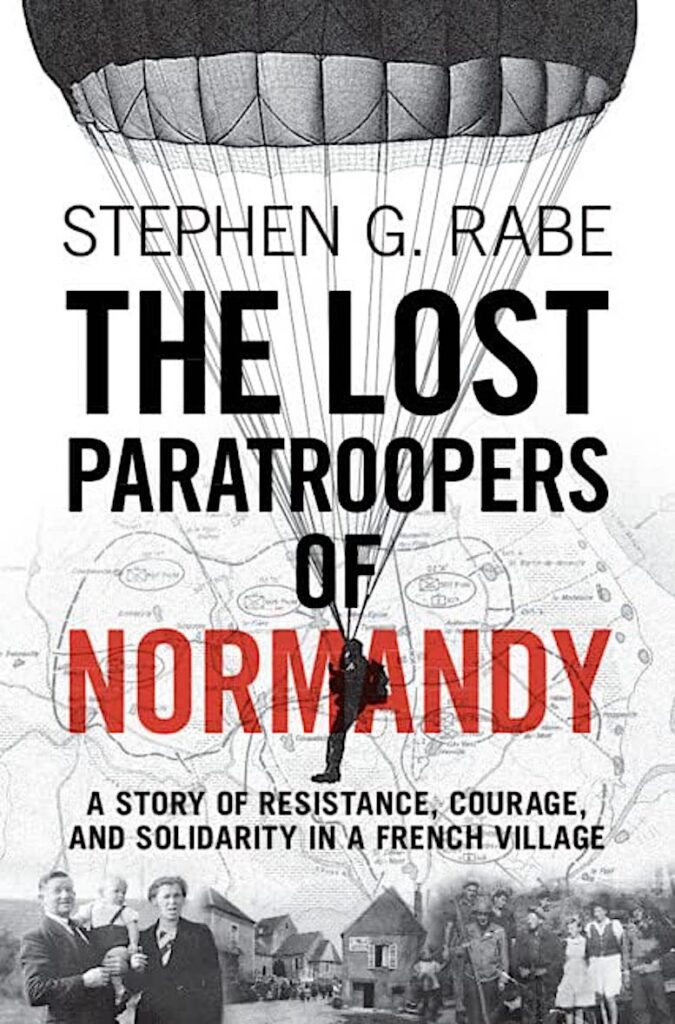Kitty Kelley Book Club: ‘The Lost Paratroopers of Normandy’
By • May 10, 2023 0 1383

Honoring the heroes of a little-known episode from WWII.
Reviewed by Kitty Kelley
“The Lost Paratroopers of Normandy” could be a magnificent film under the direction of Steven Spielberg with a script by Robert Rodat (“Saving Private Ryan”). Right now, it’s a sprawling narrative report — factual and prosaic — written by Stephen G. Rabe, a retired history professor and veteran of the U.S. Marine Corps, that documents an important part of D-Day history.
In this, his 13th book, Rabe focuses on “new information” he unearthed about what happened to the 12 planeloads of paratroopers from the 82nd and 101st Airborne divisions, including his father, Staff Sergeant Rene E. Rabe, who were dropped hopelessly off-target on June 6, 1944, and landed in the marshy waters of northwestern France. It was the worst mis-drop of any U.S. airborne unit on D-Day.
Yet the 900 residents of Graignes, a small Catholic village, saw the billowing white “silk from the sky” as God’s deliverance from German occupation. They embraced the paratroopers with warm hearts and heroic hands, particularly the women and children, who cooked around the clock to provide two meals a day for the 182 paratroopers — Allied troops deemed “the enemy” by the Nazis. The people of Graignes opened their barns and stables to hide the airmen; scouted the area to gather covert intelligence regarding German troop movements; and hauled wagonloads of equipment salvaged from the muddy swampland of the marais, where the men had landed 18 miles off-target.
After six harrowing days holding off the advancing Germans, most of the paratroopers had to flee after running out of ammunition. Villagers provided nighttime water transport for the remaining soldiers to move on to Carentan — the port town between Utah and Omaha beaches — which remained liberated thanks to the courage of those in Graignes. Such heroism deserves the majestic narrative it gets in these pages.
Most of the valiant men in the village ultimately lost their lives to marauding Boches, who also murdered U.S. medical personnel who’d stayed behind to tend the casualties. Ignoring all protocols of the Geneva Conventions, the Nazis slaughtered the medics, bayoneted the wounded, and shot the local priest, his religious associate, and two elderly housekeepers. Some villagers were forced to dig their own graves and then stand in them while the Nazis put a bullet in the back of their heads. The Germans then torched the village, burning all but two of its 200 structures, and ordered those remaining to evacuate.
The villagers returned on July 22, 1944, when U.S. forces liberated Graignes, and attended Mass on that day to commemorate the military and civilian victims of the attack and occupation. Years later, Graignes brides would wear wedding gowns made from the white “silk from the sky” of the Allies’ parachutes.
Rabe does a fine job describing the mystique of paratroopers as military rockstars whose rigorous physical training earned them elite status. Drill instructors — notoriously merciless in their schooling methods — maintained that a single paratrooper was superior to five soldiers.
Led by the charismatic Gen. James M. Gavin, the men of the 82nd Airborne were “a special kind of animal … their first impression …overwhelming physical presence.” Each was “as finely trained as a champion boxer.” Once a week, Gavin led his charges on a 30-mile forced march, warning them, “If you fall out, you ship out.” A sign on the shed where the parachutes were packed read: “Through these portals pass America’s finest troops. Pack well, and jump again.”
Most of the paratroopers had rough childhoods, came from broken homes, excelled at sports and volunteered for jump school for the extra $50 a month (equivalent to $846.62 today) it offered. All of them were tough. Those who survived the war lived long lives back home; the last one died in 2020 at age 99.
Particularly moving in the book is the photograph of General Dwight D. Eisenhower meeting with members of the 101st Airborne on the evening before D-Day. “The confident paratroopers reassure the anxious general,” writes Rabe. “They promised Eisenhower that they would accomplish their missions.”
In 1952, as he campaigned for the presidency, Eisenhower spoke to a veterans’ group about the Normandy invasion and was visibly pained by the memory of soldiers and paratroopers dying as a direct result of his command decisions. Overwhelmed by grief, Rabe writes, the general covered his face with a handkerchief.
Twelve years later, Eisenhower returned to Normandy on the 20th anniversary of D-Day and was filmed walking among the 9,000 Christian crosses and Stars of David at the American Cemetery in Colleville-sur-Mer near Omaha Beach. The former president recalled the men who’d sacrificed themselves in the name of global peace, lamenting that they never had a chance to live full lives. It’s impossible to put down “The Lost Paratroopers of Normandy” without feeling a huge debt of gratitude for all they gave up.
Georgetown resident Kitty Kelley has written several number-one New York Times best-sellers, including “The Family: The Real Story Behind the Bush Dynasty.” Her most recent books include “Capturing Camelot: Stanley Tretick’s Iconic Images of the Kennedys” and “Let Freedom Ring: Stanley Tretick’s Iconic Images of the March on Washington.” She serves on the board of BIO (Biographers International Organization) and Washington Independent Review of Books, where this review originally appeared.

